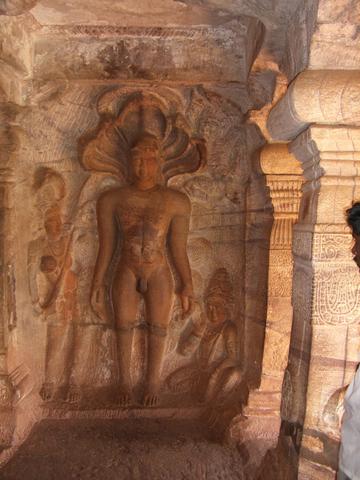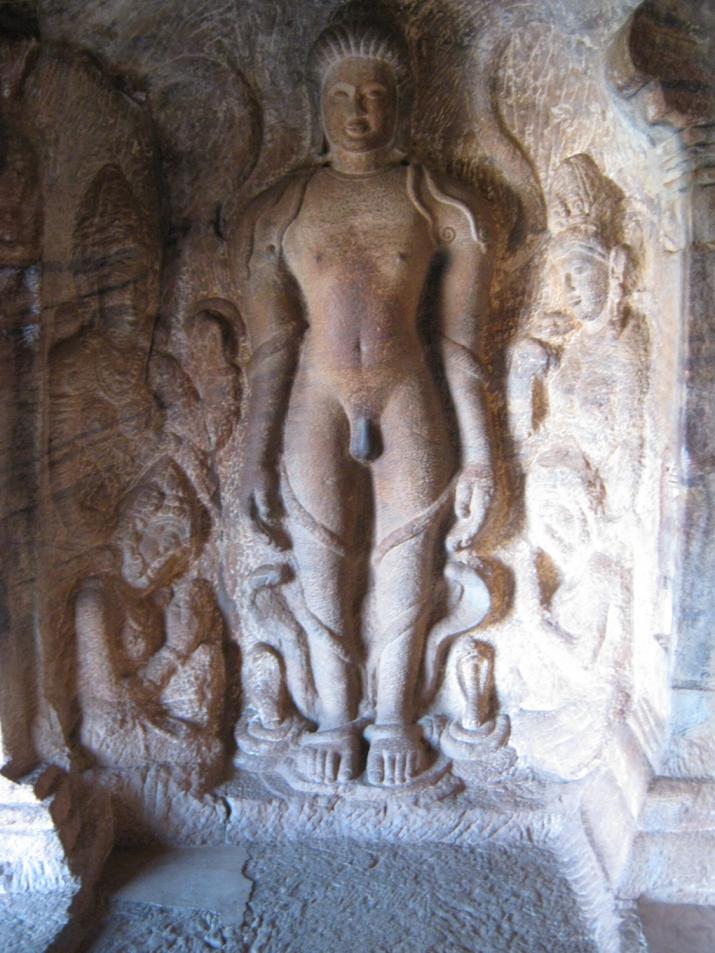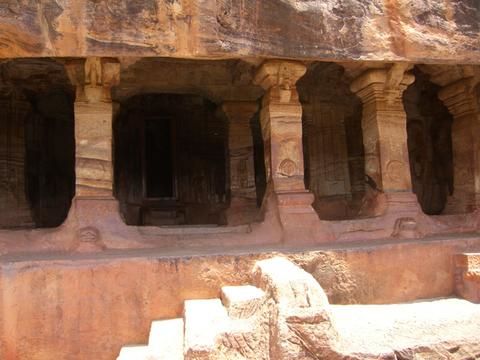
This paper was published in 1935 in The Jaina Gazette (Vol. XXXII, No. 1, January 1935, pp. 21-24). To illustrate the site of Badami some modern pictures are added to the text.
The Rock Caves at Badami
Certain of the Indian rock-cave temples are well-known, partly because they are within easy distance of the railway and large cities, and partly because travellers have frequently described them. But the caves at Badami are not so well-known to the ordinary visitor who is not prepared to make the detour from the well worn routes in order to visit them.
The lover of archaeology must become acquainted with the four caves there, if he is to obtain anything like a complete view of the system of rock caves in India. Unfortunately the Buddhists do not appear to have extended their woork as cave builders so far south as this, and the result is we have only the Brahmanical and Jain specimens to examine. But these are of the greatest interest, for the sculptures on the walls are on an ambitious scale.
There is another feature of these caves which gives the group additonal importance to archaeologists. In cave No. 3 we have an inscription which gives the date on which that cave was made, the only instance we have of a definite date in the rock caves of the country. The inscription says that the cave was excavated in the twelfth year of the reign of King Kirtivarman I, in the “500th year alter the inauguration of the Saka King.” The date is therefore 578 A.D. As there is a great similarity between all the caves here, though belonging to different faiths, Fergusson surmises that all of them were excavated between 575-680 A.D.

Badami Cave No. 4
Let us visit the caves in order. The first is a Shaiva Cave. On the front is a hall 42 feet wide and 26 feet deep, with an image of Shiva, above five feet high and possessing eighteen arms. On the inside verandah, on the left side, there is a figure of Harihar, 7 feet 9 inches high. There are several sculptures of Shiva and Parvati. The entrance to this cave is somewhat wider than the Buddhist caves found at Ellora, and is divided into three divisions by two pillars, with simple bases, and some little carving on the upper parts. The cave is reached by a flight of steps, for it is some fifty feet above ground.
Passing on to cave No. 2, the first thing that strikes one is the row of dwarfs carved on the basement of the cave. On both sides of the verandah are huge images which serve as dvarapalakas or doorkeepers. They are nearly six feet in height. The opening in the cave is divided by four square pillars bearing a considerable amount of carving. There is a representation of Vishnu as a boar on the left-hand side but this is not so imposing as the one in the next cave to be visited.
Reference has already been made to the importance of the third cave on account of its possessing an inscription giving a definite date. But apart from this, it is the most interesting from the point of view of sculpture. The front verandah measures about seventy feet; the cave inside is 65 feet long and about 50 feet deep.

Badami Cave No. 4
On the outside of the cave, cut in the face of the projecting rock is a huge image of Vishnu taking his great stride when he crossed the heaven, and underneath are many images of devotees. But the finest figures are those on the right and left of the verandah. On the east side there is a four-armed Vishnu seated on the body of the great snake, Ananta. This snake has coiled himself round the figure three times and has its five hoods spread over him.
The front left hind of Vishnu rests on the calf of his leg, while the back left hand holds a couch shell. In the front right hand there is a cluster of fruit; the back left hand holds a heavy sword the weapon the Hindus used to hurl at their enemies. Around his neck are three necklaces while a belt of gems adorns the waist. The figure is surrounded with a number of smaller sculptures.
On the right of the verandah is a fine carving of Vishnu as the man-lion. He has four arms, the one on the left resting on a large club. Over his shoulders are a number of floating figures holding gifts and garlands in their hands. There is some rather elaborate carving on various parts of this figure, but most striking of all are the beautifully worked pillars, some of which are gems of art. The roof is also elaborately carved. Various images of Vishnu under his many forms adorn the interior of the cave.

Badami Cave No. 4 (Entrance)
Cave No. 4 is a Jain cave and has all the characteristics of a Jain structure. It is probably the latest of the caves here. The verandah is thirty-one feet long and has four square capitals in front, each having bracket capitals. There are several Jain images inside, the chief of which is that of Mahavira, the last of the twenty Tirthankars. There are lion and alligator heads in bas-relief on the walls. Little Jain images are inserted in the main pillars and in the walls.
While the caves are the chief interest of Badami, it is worthy of note that it possesses many historic associations. There are two strong forts on the hill, about three hundred yards apart, and at a height of two hundred and forty feet above the plain. The town in the old days could only be entered by strong gateways which were always well guarded. The North fort is built on detached pieces of rock and there is a chasm of between thirty and one hundred feet deep. This was carefully filled with strong masonry.
The south fort is on a rock above the caves. The fort has a long history dating from the time of Pallawas, in the sixth century. It passed from one dynasty to another, and in 1746 it was ceded to the Peshwas. The Mahrattas then obtained possession. In 1778 Haidar Ali captured it but eight years later it was ceded to the Nizam. For many years after that the Mahrattas gave trouble, and when they attempted to lay siege to the fort they caused a great deal of damage to the surroundings villages.
In 1818 the British took it after a siege of five days but in 1840 a band of Arabs, under a blind Brahman leader, captured the city. Later the British, under Mr. Bettington of the Civil Service, took possession of the fort.